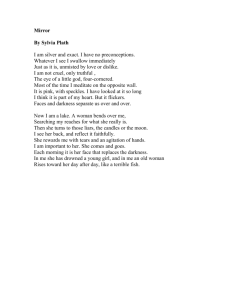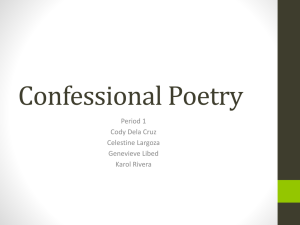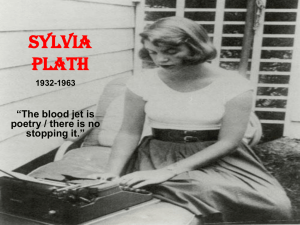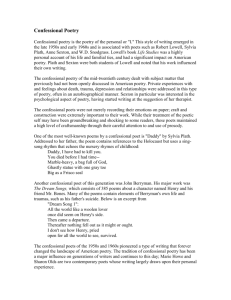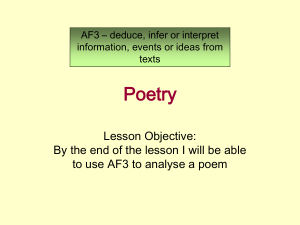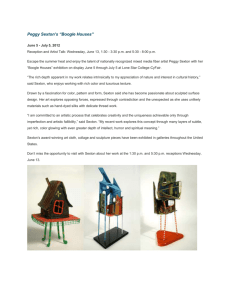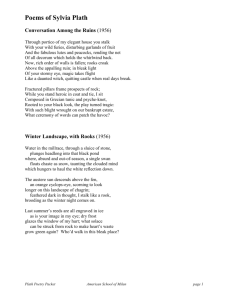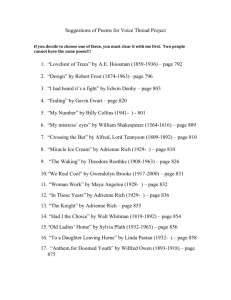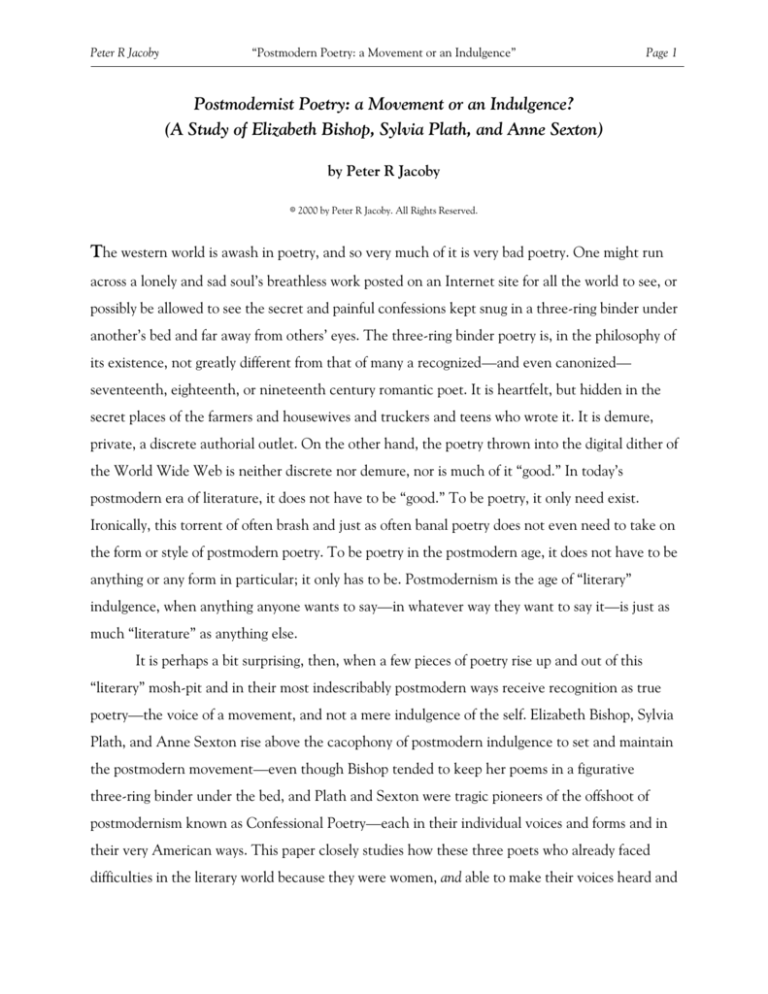
Peter R Jacoby
“Postmodern Poetry: a Movement or an Indulgence”
Page 1
Postmodernist Poetry: a Movement or an Indulgence?
(A Study of Elizabeth Bishop, Sylvia Plath, and Anne Sexton)
by Peter R Jacoby
8 2000 by Peter R Jacoby. All Rights Reserved.
The western world is awash in poetry, and so very much of it is very bad poetry. One might run
across a lonely and sad soul‟s breathless work posted on an Internet site for all the world to see, or
possibly be allowed to see the secret and painful confessions kept snug in a three-ring binder under
another‟s bed and far away from others‟ eyes. The three-ring binder poetry is, in the philosophy of
its existence, not greatly different from that of many a recognized—and even canonized—
seventeenth, eighteenth, or nineteenth century romantic poet. It is heartfelt, but hidden in the
secret places of the farmers and housewives and truckers and teens who wrote it. It is demure,
private, a discrete authorial outlet. On the other hand, the poetry thrown into the digital dither of
the World Wide Web is neither discrete nor demure, nor is much of it “good.” In today‟s
postmodern era of literature, it does not have to be “good.” To be poetry, it only need exist.
Ironically, this torrent of often brash and just as often banal poetry does not even need to take on
the form or style of postmodern poetry. To be poetry in the postmodern age, it does not have to be
anything or any form in particular; it only has to be. Postmodernism is the age of “literary”
indulgence, when anything anyone wants to say—in whatever way they want to say it—is just as
much “literature” as anything else.
It is perhaps a bit surprising, then, when a few pieces of poetry rise up and out of this
“literary” mosh-pit and in their most indescribably postmodern ways receive recognition as true
poetry—the voice of a movement, and not a mere indulgence of the self. Elizabeth Bishop, Sylvia
Plath, and Anne Sexton rise above the cacophony of postmodern indulgence to set and maintain
the postmodern movement—even though Bishop tended to keep her poems in a figurative
three-ring binder under the bed, and Plath and Sexton were tragic pioneers of the offshoot of
postmodernism known as Confessional Poetry—each in their individual voices and forms and in
their very American ways. This paper closely studies how these three poets who already faced
difficulties in the literary world because they were women, and able to make their voices heard and
Peter R Jacoby
“Postmodern Poetry: a Movement or an Indulgence”
Page 2
understood above the postmodern din. It also looks at what these three poets had to say.
Postmodernism
To begin to understand the incredible achievements of these three women, one should
attempt to understand the meaning of postmodernism. This presents immediate difficulties, for the
very nature of postmodernism makes it difficult to “pin down” in any sensible way. Literary critic
Terry Eagleton says of postmodernism:
Truth is the product of interpretation, facts are constructs of discourse, objectivity is just
whatever questionable interpretation of things has currently seized power, and the human
subject is as much a section as the reality he or she contemplates, a diffused, self-divided
entity without any fixed nature or essence. (201)
He further explains, “Postmodernism proper can then best be seen as the form of culture which
corresponds to this world view” (201). For Eagleton (and not just a few others), the difficulty this
presents is not easily solved:
We are always, in short, installed firmly on the inside of the culture we hope to criticize, so
thoroughly constituted by its interests and beliefs that to put them into radical question
would involve leaping out of our own skins. (203)
Ralph Smith, in his article, “The Question of Modernism and Postmodernism,” quotes critic
Charles Jencks on postmodernism and postmodernists and the difficulty most people have in
understanding it:
Most peopleYdon‟t have a very clear idea of what it means. They can be forgiven this
confusion because Post-Modernists don‟t always know and, even when they think they do,
often find themselves disagreeing. (Smith 2)
Most everyone, including its practitioners, does agree that postmodernism approaches the
dominant culture in an adversarial manner. It has become a weapon, designed to smite certain
ideas prevalent since the Enlightenment—including the belief in an objective reality approachable
through reason and science. Wary of Western logic and the scientific method, postmodernists turn
to cultural relativism. Necessarily or not, the language used to describe postmodernism becomes
quite tortuous at times, such as that used by postmodernist Judith Butler of the University of
California at Berkeley and quoted in an article on the meaning of postmodernism by Daniel
Peter R Jacoby
APostmodern Poetry: a Movement or an Indulgence”
Page 3
Seligman:
The epistemological paradigm that presumes the priority of the doer to the deed establishes
a global and globalizing subject who disavows its own locality as well as the conditions for
local intervention. (Seligman 155)
As Seligman says, “Uh-huh” (155). He also points out that feminism and postmodernism seem to
be tightly linked, although, here again, the nature of the connection is a bit elusive. As Seligman
says, not without something of a sardonic tone:
In the feminist variant, postmodernism often denies the simple-minded construct in which
there are two sexes. The aforementioned Ms. Butler concludes her book, Gender Trouble,
by ridiculing the “binaryism of sex, and exposing its fundamental unnaturalness.” Feminist
postmodernists also tend to be real hard-liners on logic and reason. The Cambridge
Dictionary of Philosophy credits them with taking postmodernism on a path down which “the
conception of reason itself … is often redescribed as … (en)gendered, patriarchal,
homophobic, and deeply optional.” (155)
Postmodernism, as one might well imagine, has drawn quite a few detractors, mostly from
those who believe in the superiority of “high art” over “low art,” which postmodernism rejects.
Jonathan Meades, a writer/producer for BBC 2 in London, is one such detractor:
I did a straw poll of two experts to find out what they thought postmodern means today.
Jonathan Green: “It‟s a posh word for plagiarism.” Martin Rowson: “I worried about this six
years ago and gave up on it. It‟s the objectification of aesthetics. Refrigerators and seagulls:
they‟d compete with each other.” (Meades 63)
“Postmodernism had moved in a decade from being as ingrown and recondite as John Cage to a
state of educationally deficient infantilism like the Bay City Rollers” says Meades. “It contained an
in-built apparatus for deflecting adverse criticism:
“That‟s crass and vulgar.”
“No it‟s not—it‟s playing with ideas of crassness and vulgarity.” (Meades 63)
For perhaps the simplest yet most erudite explanation of postmodernism, a look back to its
early moments of ascendency and a truly great philosopher and critic, Ludwig Wittgenstein, should
prove useful. Says Wittgenstein, “Even if the most trustworthy of men assures me that he knows
things are thus and so, this by itself cannot satisfy me that he does know. Only that he believes he
Peter R Jacoby
APostmodern Poetry: a Movement or an Indulgence”
Page 4
knows” (Wittgenstein 20e). Wittgenstein adds, “The difficulty is to realize the groundlessness of
our believing” (24e).
What Wittgenstein explains so well is the relativistic nature of postmodernism. The
movement calls all points of view into question, and then pronounces them equal in the sense that
there is no knowable Truth (with a capital “T”), so any particular belief in a truth (small “t”) is just
as valid as any other. This is why all poetry is encouraged, not just “good” poetry; who is to say what
is “good” or not? The Internet—like Gutenberg‟s movable type press five hundred years before it,
and in fact exactly like it—assures the global proliferation of poetry, good and bad (depending on
one‟s point of view). Postmodernism also allowed—if not assured—the literary careers of Bishop,
Plath, and Sexton.
Elizabeth Bishop
An important female poet who is hard to categorize is Elizabeth Bishop. Influenced by
Marianne Moore, Bishop intensely observes exotic and common things, always renders them in a
most uncommon language, and many of her observations suggest a psychological dimension not
unrelated to the confessional poetry school (McHenry 186-88). Her poems, displaying a close
attention to physical reality and nature and an almost analytic precision of language, are buoyed by
a rapt exploration of subjective experience into realms of speculation, metaphysics, and even
fantasy.
After a lengthy stay in Mexico, Bishop returned to the United States for a time. She was a
consultant in poetry at the Library of Congress in 1949-1950, and in the latter year she was the
recipient of the American Academy of Arts and Letters Award. For several years thereafter she
lived mainly in Petrópolis in Brazil near Rio de Janeiro (188). When poet Robert Lowell read her
poem “At the Fishhouses” in The New Yorker, he recognized immediately the “great splendor” of
the descriptive part, but questioned “ „a little the word BREAST in the last four or five lines—a
little too much in the context perhaps; but I‟m probably wrong‟ ” (Kalstone 121). Lowell knew he
was seeing something different, something important in poetry in the developing postmodern era.
Here was an extremely fine poet who was capable of living in and writing from both the modern
and postmodern points of view in a smoothly blended fashion. Lowell was the putative “founder”
Peter R Jacoby
APostmodern Poetry: a Movement or an Indulgence”
Page 5
and de facto leader of the confessional poetry form, and he saw something quite remarkable in
Bishop. She had at once both a confessional and a reserved, private style. “By the end of „At the
Fishhouses,‟ Bishop‟s own place as protagonist is apparent; her sense of being an outsider is
powerfully banished at the cost of identifying herself with severe, if universal, natural laws” (122).
This seems a likely juncture of the two styles. A pair of Bishop biographers said of her:
She was tragically isolated. Her father died when she was a baby. Her mother was insane. If
anyone had a right to psycho-drama, she did, and yet, instead, she focused simply on the
way things looked.... Elizabeth saved herself by keeping her eyes on grains of quartz and
amethyst while the world pounded around her. (Fountain and Brazeau 189)
It is little wonder she was as withdrawn as she was. Financially independent, she was able to
travel, live for an extended time in Brazil, and concentrate on her writing. Perhaps the truest
statement in Fountain and Brazeau‟s biography about this internationally acclaimed and quietly
lesbian poet, is “Bishop would not have been comfortable with a biographical study of this sort”
(xi). Scholarship on Elizabeth Bishop has traditionally praised her reticence, especially in matters
of identity, the female body, and female sexuality (Stevenson 126). One probably finds the secret
to understanding Bishop‟s unique poetic voice in an emerging postmodern world by realizing her
rare ability to live in or out of that world to whatever extent she wished, and to take the time to
observe closely and keenly. Bishop was to go on to receive many accolades for her poetry, but she
remained a very private and taciturn person. Only on rare and often serendipitous occasions did
someone record some of her readings—she did not consider herself a good reader and disliked
being recorded—and I quite serendipitously heard a recording of Elizabeth Bishop reading her
poem “Filling Station.” She was charming. She was also strangely graceful amid her faulty reading,
and I felt a strength and durability in her voice.
Sylvia Plath
Strength and durability, regrettably, are not words one would normally associate with a
younger, much less modernist, if at all, and very postmodern literary contemporary of Bishop‟s,
Sylvia Plath. Plath suffered a breakdown at the end of her junior year of college, but recovered well
enough to return and excel during her senior year, receiving various prizes and graduating summa
cum laude. In 1955, having been awarded a Fulbright scholarship, she began two years at
Peter R Jacoby
APostmodern Poetry: a Movement or an Indulgence”
Page 6
Cambridge University. There she met and married the British poet Ted Hughes and settled in
England, bearing two children (“Sylvia Plath” Poetry Exhibits). Her first book of poems, The
Colossus (1960), demonstrates her precocious talent, but seems far more tame—perhaps even
conventional—than the work that followed. Having studied with Robert Lowell in 1959 and been
influenced by the confessional style of his collection Life Studies, she started on the new work that
would ultimately affirm her posthumous reputation as a major poet. As a chilling record of her
developing mental illness, the poems that were collected after her suicide (at age 31) in 1963 in the
volumes Ariel, Crossing the Water, and Winter Trees are graphically macabre, hallucinatory in their
imagery, but full of ironic wit, great poetic skill, and tremendous emotional power. Her Selected
Poems was published by Ted Hughes in 1985 (ibid). In her poems, Plath‟s demons outlived her. One
of those demons she shows us in her poem “Daddy,” and at the same time demonstrates a very
different voice than the pensive, reticent, almost “imagist” Bishop.
Images of victimization in Plath‟s “Daddy”—of Nazis, swastikas, barbed wire, fascists,
brutes, devils, and vampires—are so frantic, imposing, and vituperative that the poem seems more
out of control than it actually is. I had the privilege to hear a recording of Plath reading “Daddy”;
the level of anger was astonishing. When read rapidly and angrily, without paying attention to its
many unexpected pauses, Plath‟s poem, indeed, seems like a runaway train barreling through one
psychic nightmare after the other, until the speaker pulls the emergency cord that irrevocably
separates the self from the tormenting other in the very last line: “Daddy, daddy, you bastard, I‟m
through” (Plath 224). Suggestive of the poet‟s control over her material, the stanzas containing the
most end-stopped lines (four stops each in stanzas 7, 14, and 16) allude to concentration camps,
torturers, vampires, and the like, while the stanzas with the fewest (one stop in stanza 1; no stops in
stanza 11) characteristically show more ambivalence toward victimization. In effect, the speaker
takes away some of the power of her (alleged) tormentors by end-stopping their lines. Psychological
control in this poem of the self over the other, however, is not that simple. A number of critics have
indicated another stylistic pattern that recurs in “Daddy”: the compulsive use of the Aoo” sound
that inevitably draws the reader back to the “you” and “do” rhymes of the first line. In fact, the
ubiquitous rhyme is repeated more than 60 times. Susan R. Van Dyne considers this “verbal tic” to
Peter R Jacoby
APostmodern Poetry: a Movement or an Indulgence”
Page 7
be a sign “of a disordered psyche and poetic incontinence,” an “overdetermined” use of “regressive
and repetitive language” (Van Dyne 48-49). Other critics regard the repetition as childlike: “The
language of the poemYteeters precariously on the edge of a preverbal abyss—represented by the
eerie, keening „oo‟ sound with which a majority of the verses end” (Axelrod 56). And, just as the
stake in the vampire‟s Afat black heart” (l. 56) would only prevent the undead from causing further
misery, the speaker in Plath‟s “Daddy,” with memories of alleged victimization echoing in every
broken and repeated nursery-sounding rhyme, can achieve only a partial victory over the “man
who / Bit my pretty red heart in two” (ll. 55-56).
Some critics do not feel there was much of the “real” Plath in “Daddy” at all. During a panel
discussion on poetic voice, poet Stephen Yenser had this to say when asked whether he believed
whether each poet or each poem had a true voice:
I think that poets, at least implicitly, construct “selves,” and even my favorite confessional
poets do this: Berryman in The Dream Songs, Sylvia Plath in Ariel. “Daddy” is not in Sylvia
Plath‟s “voice.” That‟s a dramatic monologue, that poem. (Yenser 201)
Plath wrote “Daddy” on October 12, 1962—four months before her suicide; fifteen days
before her thirtieth birthday; on the twentieth anniversary of her father‟s leg amputation (alluded
to in the poem, ll. 9-10); and on the day she learned that Ted Hughes, the alleged “vampire” who
drank her blood for seven years (ll. 73-74), had agreed to a divorce (Wagner-Martin 28, 243). Her
“victory,” like her life, proved short. Plath lived at the extreme edge of a decentered, postmodern
world in which nothing was absolute, nothing was True—nothing but the pain and anguish she
revealed in her fragmented, wickedly and tragically playful poems. In this way, Plath was truly a
daughter of the postmodern era.
Anne Sexton
Another of postmodernism‟s daughters was Anne Sexton, a contemporary of Plath in every
way, including suicide. Sexton, too, was a confessional poet. And Sexton faced much of what Plath
faced just newly into the second half of the twentieth century:
Links between sex, the weaponry of war, and death are encapsulated in a variety of cultural
artifacts and terms: women enshrined in soldiers‟ “pin-up girl” posters or labeled sexual
Peter R Jacoby
APostmodern Poetry: a Movement or an Indulgence”
Page 8
“bombshells,” “male bonding,” and the emergence of the “he-man.” Thus, mid-century
female poets faced a much sharper set of cultural and social restrictions concerning writing
and being. Sylvia Plath is a pivotal figure in the project of re-establishing “the new” once
again. (Rubenstein 31)
One could carelessly think that these two women, Plath and Sexton, were so alike in age,
chosen method of expression as confessional poet, and untimely suicide, that if not twins, they
might easily be sisters. The truth is somewhat different (of course it is; this paper is about
postmodernism, after all). Although all the above were shared traits, the difference between Plath
and Sexton was that Plath always wanted to become a famous writer but often felt she was lazy
because she wasn‟t working for a Ph.D., or working on a book, or having four children and a
profession. Sexton on the other hand, never thought she was special at all. She learned poetry only
when she needed it to survive; it gave her something to do and (supposedly) kept her from killing
herself (“Sylvia Plath and Anne Sexton: Two Confessional Poets.” par. 3). Plath once told a BBC
interviewer:
I think particularly of the poetess Anne Sexton, who writes also of her experiences as a
mother; as a mother who‟s had a nervous breakdown, as an extremely emotional and
feeling young woman. And her poems are wonderfully craftsmanlike poems, and yet they
have a kind of emotional and psychological depth which I think is something perhaps quite
new and exciting. (par. 4)
The only thing Sexton thought was similar in their work, was that they both were
entranced by death. Sexton said that Plath “had the suicide inside her. As I do. As many of us do.
But if we are lucky, we don‟t get away with it and something or someone forces us to live” (par. 4).
In 1955, at the age of 27 and following the birth of her second daughter, Sexton suffered her second
nervous breakdown and was hospitalized for a second time; her children were sent to live with her
husband‟s parents. That same year, on her twenty-eighth birthday, she attempted suicide.
Sexton, like Plath, was using poetry to find herself (and her self-worth), so it is no surprise
that, like Plath and Lowell, she eschewed the Eliotic school that was so committed to the removal
of the poet from the poem. She, like most other postmodernists (including the subset of
confessionalists), went in exactly the opposite direction, desperately trying to find her Self in the
Peter R Jacoby
APostmodern Poetry: a Movement or an Indulgence”
Page 9
poem. Sexton biographer Caroline Hall agrees with the assessment of M.L. Rosenthal, whom Hall
quoted:
“These poems seemed to me one culmination of the Romantic and modern tendency to
place the literal Self more and more at the center of the poem in such a way as to make his
psychological vulnerability and shame an embodiment of his civilization.” (Hall 34)
Positive critical review of To Bedlam and Part Way Back, her first book, established her as a
poet “who wrote from experience” and many poems in that book, particularly “The Double Image,”
use a narrator who could be identified as a contemporary New England woman (“Anne Sexton and
Poetic Confessionalism.” par. 4). Fellow poet and critic James Dickey said in 1961 of To Bedlam and
Part Way Back,
Anne Sexton‟s poems so obviously come out of deep, painful sections of the author‟s life
that one‟s literary opinions scarcely seem to matter; one feels tempted to drop them
furtively into the nearest ashcan, rather than be caught with them in the presence of so
much naked suffering. (Dickey 63)
Some criticism of Sexton, though, reveals a disturbing trend. Sexton, while certainly not unique in
her writing of confessional poetry, is critically approached in a manner different from other
confessional poets. She wrote as any postmodern poet might write—fractured, ambiguous, difficult
to locate, and with a blunt and sometimes severe self-disclosure (not unlike Ginsberg). One critic
spoke for more than just himself when he postulated
Anne Sexton‟s “uniqueness” among the confessionals set her distinctly apart from other
confessionals, for she threatens to become a kind of legendary cultural tragedy which
supports any of a variety of interpretations—the romantic one of her as a doomed artist, the
psychiatric one of her as a schizophrenic exhibitionist, the mythopoetic one of her as a
“dying [goddess],” the “feminist” one of her as a victim of the patriarchal culture.
(Gallagher 96)
Does this not, though, place her well within the body of postmodern writers? Is not the
inability to definitively choose between doomed artist, schizophrenic exhibitionist, dying goddess,
and victim of patriarchy and assign her just one of these labels (and this is a short list) the essence
of postmodernism? She herself is fragmented and multifaceted, and offers to her reader or
Peter R Jacoby
APostmodern Poetry: a Movement or an Indulgence”
Page 10
biographer no simple and everlasting single view of Truth.
As a poet, Sexton took her readers on a poetic odyssey which was by turns confessional,
magical, and mythical. “I have gone out, a possessed witch, / haunting the black air, braver at
night,” she wrote in the poem “Her Kind”, mixing autobiography and folklore; “dreaming evil, I
have done my hitch / over the plain houses, light by light” (Sexton, in Lauter 2417). With her
updated versions of the Grimms‟ fairy tales—“Snow White and the Seven Dwarfs,” “Rapunzel,”
“Briar Rose (Sleeping Beauty)”—in her collected poems, Transformations, she found marvelous
ways to meditate on what it means to be a woman. And in her late recastings of Christian myths in
her collected poems The Death Notebooks, she attempted to create new psalms for a rapidly
changing society.
Both Sexton and Plath wound up as cautionary tales about the postmodern world where
there are no absolutes, no black-and-white, and where things are not what they are, but what one
says they are at the moment. This is bleak, cold, and often dark world where, ironically, finding
isolation becomes easy to do. In 1963 Plath stuck her head in an oven in London. Sexton told her
psychiatrist, “Sylvia Plath‟s death disturbs me. Makes me want it too. She took something that was
mine, that death was mine!” (Morrow 76). Eleven years later, in 1974, at the age of 45, Sexton
poured herself a tall glass of vodka, went into her garage and closed the door, started up the old red
Cougar, turned on the car radio, and waited until the exhaust fumes killed her. Her immediate
American predecessors certainly provided an unwholesome precedent: John Berryman (alcoholic,
suicide), Robert Lowell (episodically psychotic), Delmore Schwartz (alcoholic), Theodore Roethke
(manic-depressive), Elizabeth Bishop (alcoholic). Sexton also shared the cynicism of the
blossoming pointlessness of the postmodern age, and she had shrewd instincts. “„With used
furniture he makes a tree,‟ she wrote. „A writer is essentially a crook.‟ Maybe” (Morrow 76).
Morrow‟s “maybe” is the ultimate postmodern response to Sexton‟s comment; it extends
ambiguity.
Sexton puts her poetic talent and her troubled mind together either to show or to tell the
world—if anyone cares to listen—exactly what she was going to do, and why, in her haunting and
cynical poem “Wanting to Die”:
Peter R Jacoby
APostmodern Poetry: a Movement or an Indulgence”
Page 11
But suicides have a special language.
Like carpenters they want to know which tools.
They never ask why build.
Y
Balanced there, suicides sometimes meet,
raging at the fruit, a pumped-up moon,
leaving the bread they mistook for a kiss,
leaving the page of the book carelessly open,
something unsaid, the phone off the hook
and the love, whatever it was, an infection.
(Sexton Complete Poems 142-43)
Yet “Wanting to Die” also shows a certain romanticism, a belief in the tenderness and
everlastingness of the moment. “[S]omething unsaid, the phone off the hook” speaks
simultaneously of loss and of continuity. The implied binary oppositions in this line give it large
emotive—perhaps even modernist or romantic—power: “something unsaid” implies the possibility
of something being said, and Athe phone off the hook,” while speaking of a disconnect, implies that
connection is possible. This one line speaks volumes about Sexton‟s loneliness and fears. Even
“infection”—the last word of the poem—changes from an ugly word to a melancholy metaphor for
someone‟s treasury of hopes and dreams. As one of the master confessional poets, Sexton offers the
reader an intimate view of the emotional anguish that characterized her life. As one of life‟s great
ironies, after her second breakdown Sexton was encouraged by her doctor to pursue an interest in
writing poetry as a means of therapy. In that doctor-prescribed poetry Sexton both lived in and
invented worlds of higgledy-piggledy, a postmodern world of a highly unstable nature.
Movement or Indulgence?
Is there only one postmodern voice or poetic tradition? This paper clearly demonstrates the
answer: No. Elizabeth Bishop, the reticent and soft-spoken voice of “the details,” the little things of
life—all of which are important—is one postmodern voice. Sylvia Plath‟s often vituperative voice
of anger against her father, her husband, and her world is another postmodern voice. And Anne
Peter R Jacoby
APostmodern Poetry: a Movement or an Indulgence”
Page 12
Sexton, the tragic heroine of her own life‟s play, the person so lost in life and so daunted by it, the
person surrounded by prescription drugs and alcohol who wrote her own final and ultimately fatal
prescription on the poetic page, then filled it, is another postmodern voice. Each of these voices is
intensely personal. Yet each is decidedly transpersonal; that is, each transcends the idiom and
circumstance of you or me or any other individual and speaks to each of us directly and
meaningfully. Is this a result of a particular insight and power known and practiced by postmodern
poets, or is it because postmodernity encourages the poet to speak from that personal core that we
all as human beings have?
The ambiguity of any answer to this question leads me to believe in the postmodernity of
the question itself. This presents yet another voice of the postmodern movement, and leads back to
the title of this paper: is postmodernism a “legitimate” movement, or is it simply a fancy name for
approval of nothing more than public and literary self-indulgence? Is postmodernism art or artifice,
and if it is art, of what sort? Some say Bishop, Plath, and Sexton are products of early-twentieth
century dadaism: a urinal signed is art; “for a good time callY“ scratched onto a locker room wall is
literature. Many say they were geniuses of poetic literature, as is said of Ginsberg, whom many say
was nothing more than loud. Welcome to the postmodern world.
The answer to the title is: “yes.” Postmodernism is both a serious literary movement and the
supreme gift of permitted and encouraged self-indulgence. The importance of this duality, this
Saussurean binary opposition that might confound Derrida so, must be realized not as confusion or
the final warning of the coming of Armageddon and Apocalyptic destruction, but as one of the
most profound Are-voicings” of the many poets lurking among us—good and bad—since
Gutenberg‟s movable-type press in 1454 and the distribution of the written word that followed.
Postmodernism, and the many technologies which have developed during the postmodern
era, have given us the means. Now all we must do is summons the courage and the undiminished
voices of poets such as Bishop, Plath, and Sexton and apply them to those means. Especially the
courage: we must not be afraid of the possible “deaths” that face us, real or otherwise.
Peter R Jacoby
APostmodern Poetry: a Movement or an Indulgence”
Page 13
Works Cited
“Anne Sexton.” Poetry Exhibits. Mar. 2000. The Academy of American Poets. Accessed 19 May
2000. <http://www.poets.org/LIT/poet/asextfst.htm‟.
“Anne Sexton and Poetic Confessionalism.” Exploring Literature. R.J. McCaffrey. Accessed 18 May
2000. <http://www.conspire.org/rjm0208.html‟.
Axelrod, Steven Gould. Sylvia Plath: The Wound and the Cure of Words. 1990. Baltimore: Johns
Hopkins U P, 1992.
Dickey, James. “Review of „To Bedlam and Part Way Back‟.” Anne Sexton: Telling the Tale. Ed.
Steven E. Colburn. Ann Arbor: U of Michigan P, 1988.
Eagleton, Terry. Literary Theory: an Introduction. 2nd ed. Minneapolis: U of Minnesota P, 1998.
Fountain, Gary, and Peter Brazeau. Remembering Elizabeth Bishop. Amherst: U of Massachusetts P,
1994.
Gallagher, Brian. “A Compelling Case.” Denver Quarterly 21 (1986) : 96.
Hall, Caroline King Bernard. Anne Sexton. Boston: G.K. Hall, 1989.
McHenry, Robert, ed. “Bishop, Elizabeth (biography).” Her Heritage: A Biographical
Encyclopædia of Famous American Women. Mineola: Dover, 1995.
Meades, Jonathan. “From Po-Mo to So-So.” New Statesman. 125.315 (1996) : 62-63.
Morrow, Lance. “Pains of the Poet—And Miracles.” Time. 23 Sept 1991 : 76.
Plath, Sylvia. “Daddy.” The Collected Poems of Sylvia Plath. Ed. Ted Hughes. New York: Harper,
1981.
Rubenstein, Roberta “Altering the Critical Landscape.” Contemporary Women‟s Issues Database.
10.1 (1995) : 30-31.
Peter R Jacoby
APostmodern Poetry: a Movement or an Indulgence”
Page 14
Seligman, Daniel. “Postmodernism, in 75 Words or Less.” Fortune 134.2 (1996) :155.
Sexton, Anne. “Her Kind.” The Heath Anthology of American Literature. Vol. 2. 3rd ed. Gen. ed.
Paul Lauter. New York: Houghton Mifflin, 1998.
——. The Complete Poems. Boston: Houghton Mifflin, 1981.
——. The Death Notebooks. Boston: Houghton Mifflin, 1974.
——. Transformations. Boston: Houghton Mifflin, 1971.
Smith, Ralph A. “The Question of Modernism and Postmodernism.” Arts Education Policy Review.
96.6 (1995) : 2-13.
Stevenson, Anne. Elizabeth Bishop. New York: Twayne, 1966.
“Sylvia Plath.” Poetry Exhibits. Mar. 2000. The Academy of American Poets. Accessed 19 May
2000. <http://www.poets.org/LIT/poet/splatfst.htm‟.
“Sylvia Plath and Anne Sexton: Two Confessional Poets.” Poetic Conversations, Spring 1995. June
1995. The University of Texas. Accessed 19 May 2000.
<http://www2.cwrl.utexas.edu/slatin/sexton/sexton.html‟.
Van Dyne, Susan R. Revising Life: Sylvia Plath’s Ariel Poems (Gender and American Culture). Chapel
Hill: U of North Carolina P, 1993.
Wagner-Martin, Linda. Sylvia Plath: A Biography. New York: Simon & Schuster, 1987.
Wittgenstein, Ludwig. On Certainty. 1969. Eds. G. E. M. Anscombe and G. H. von Wright. Trans.
Denis Paul and G. E. M. Anscombe. New York: Harper, 1972.
Yenser, Stephen. “Language Invented, or What? A Panel on Poetry.” (Transcript). The Antioch
Review. 55.3 (1997) : 192-206.

